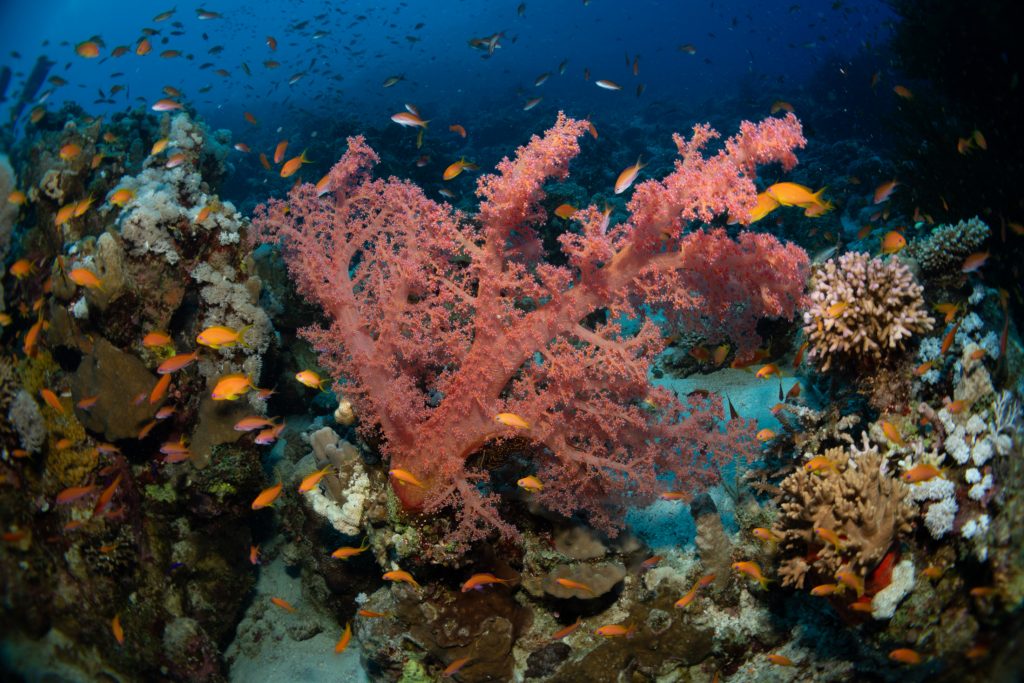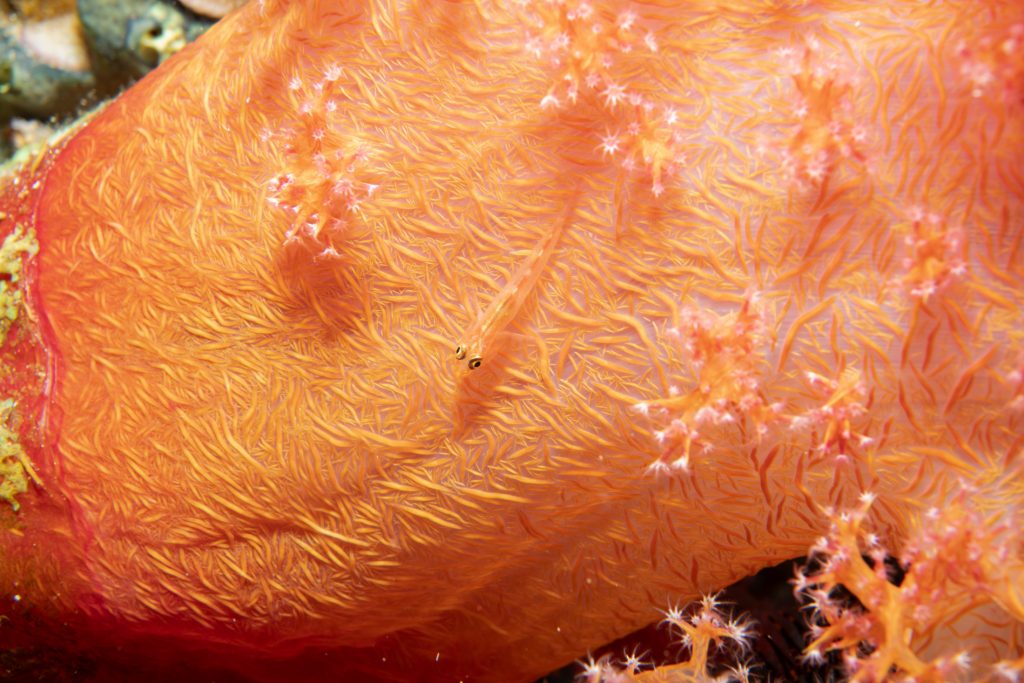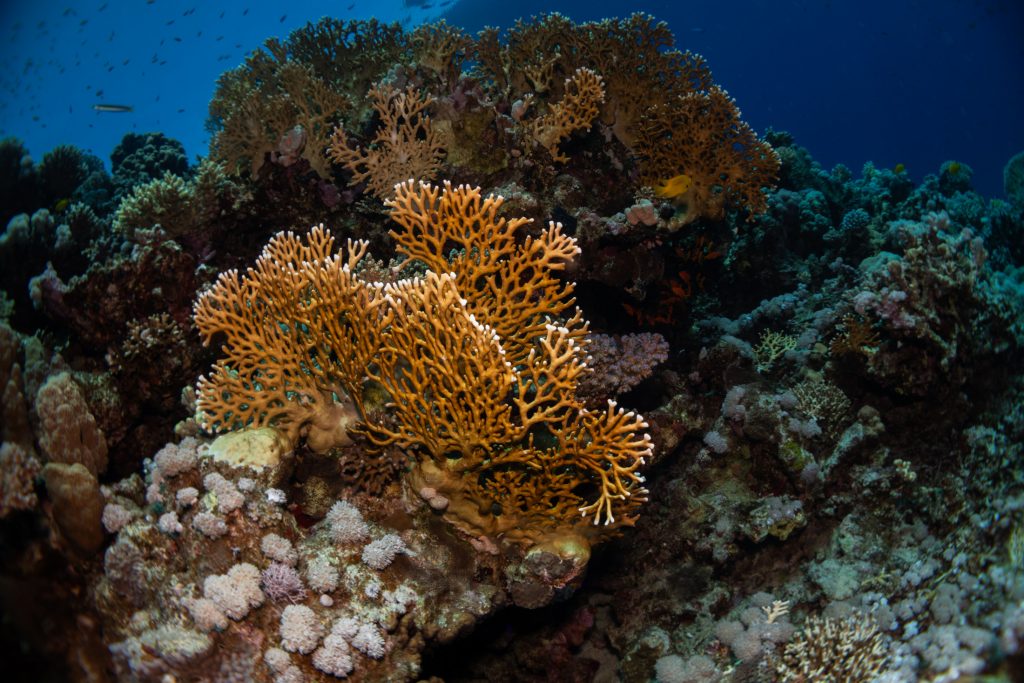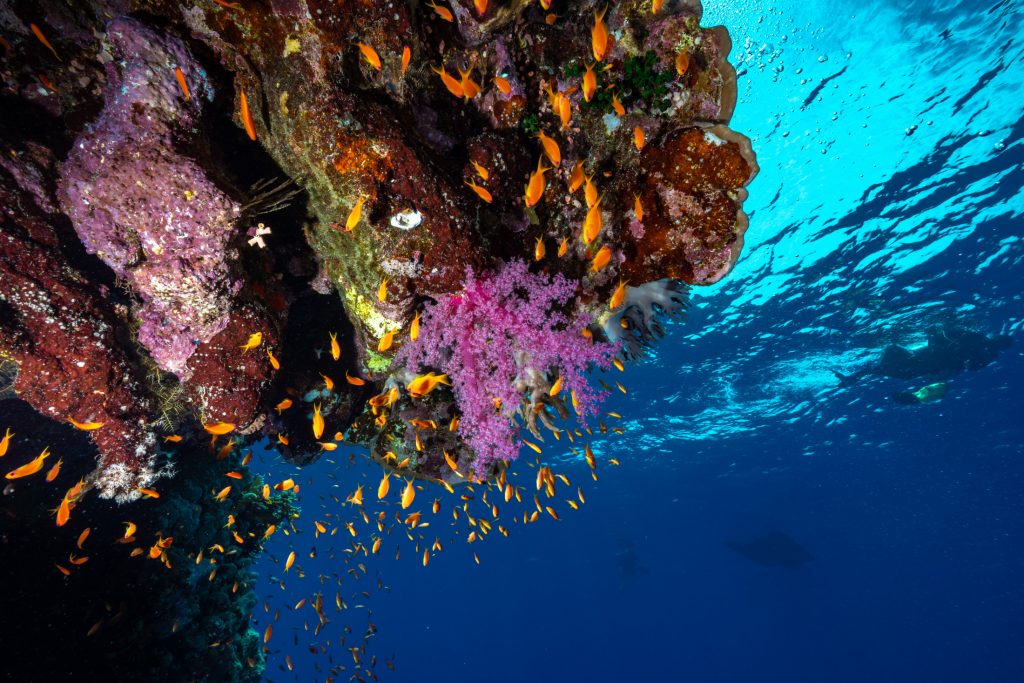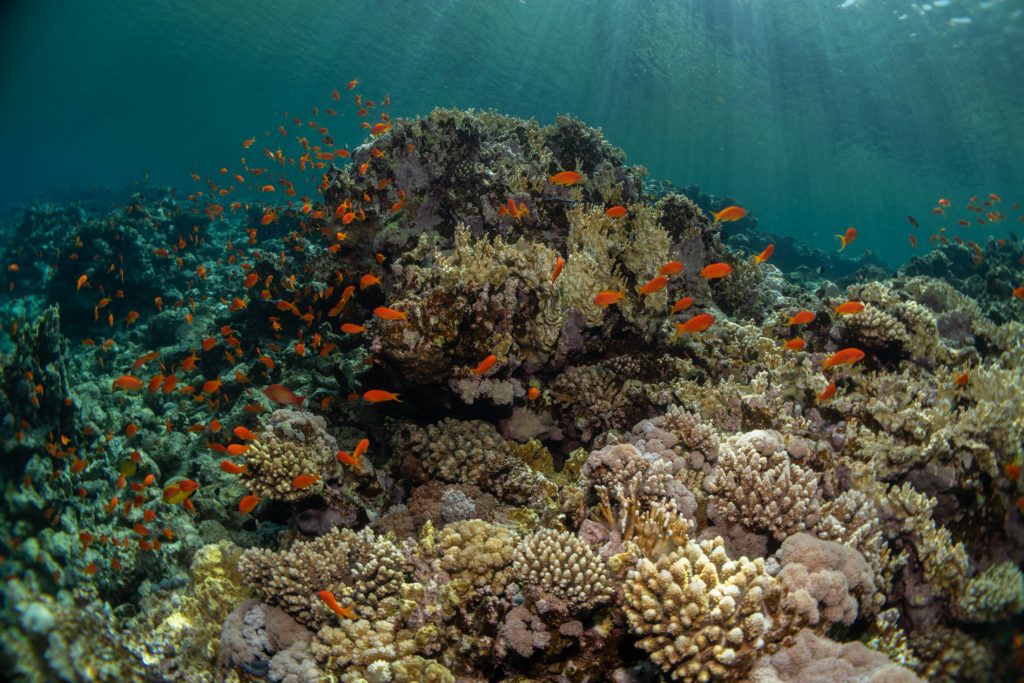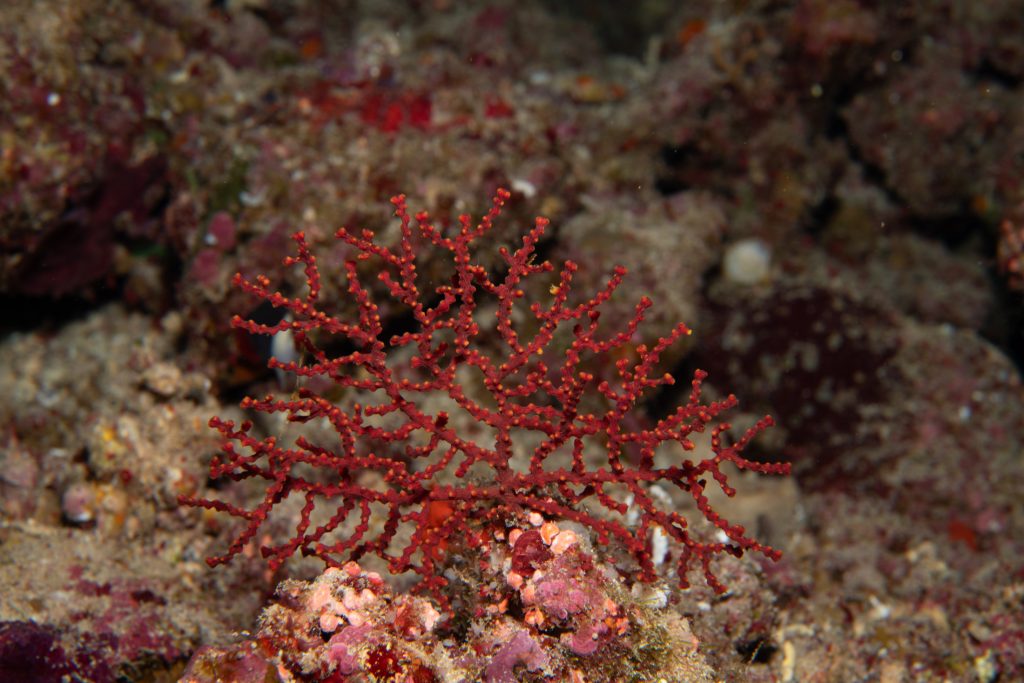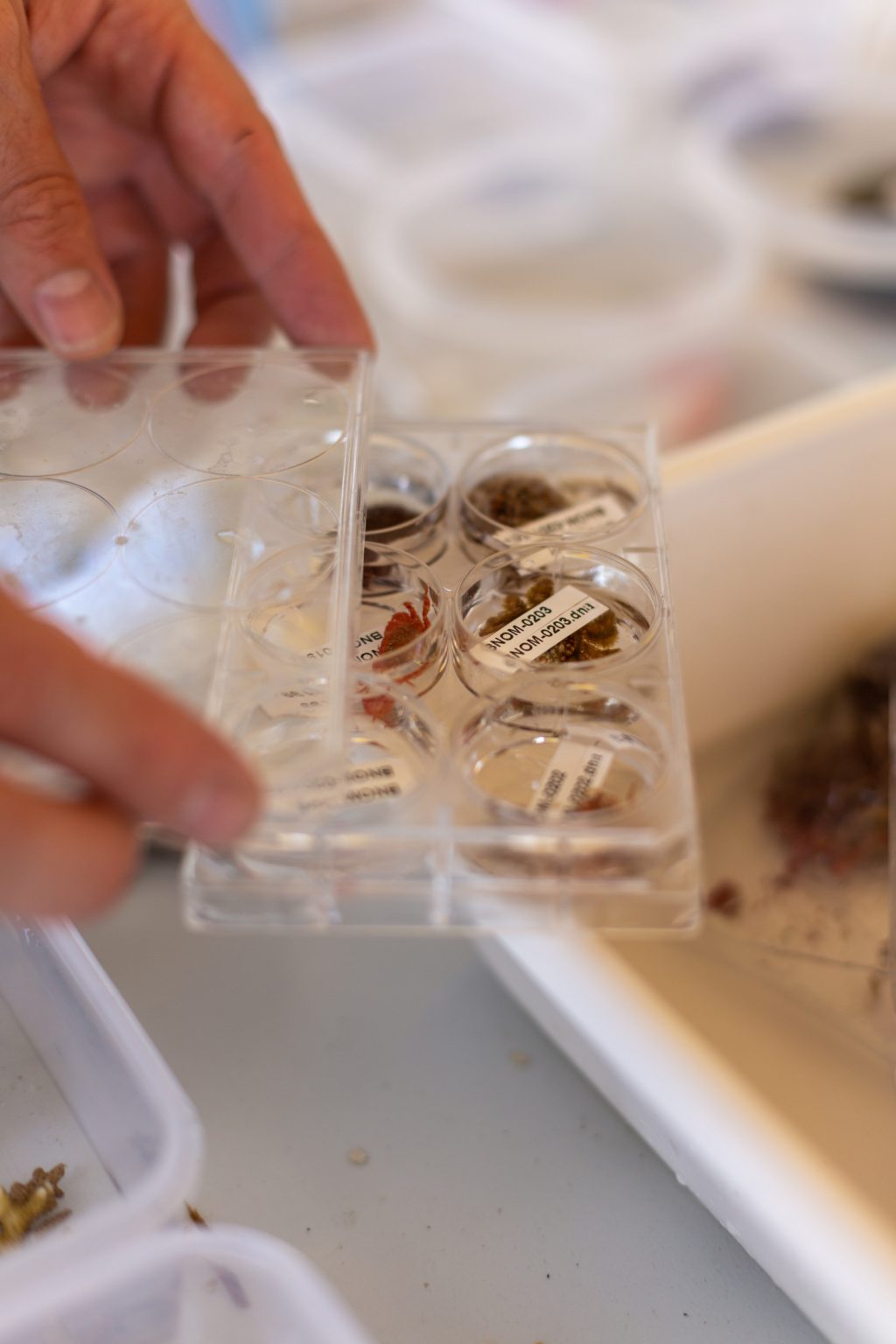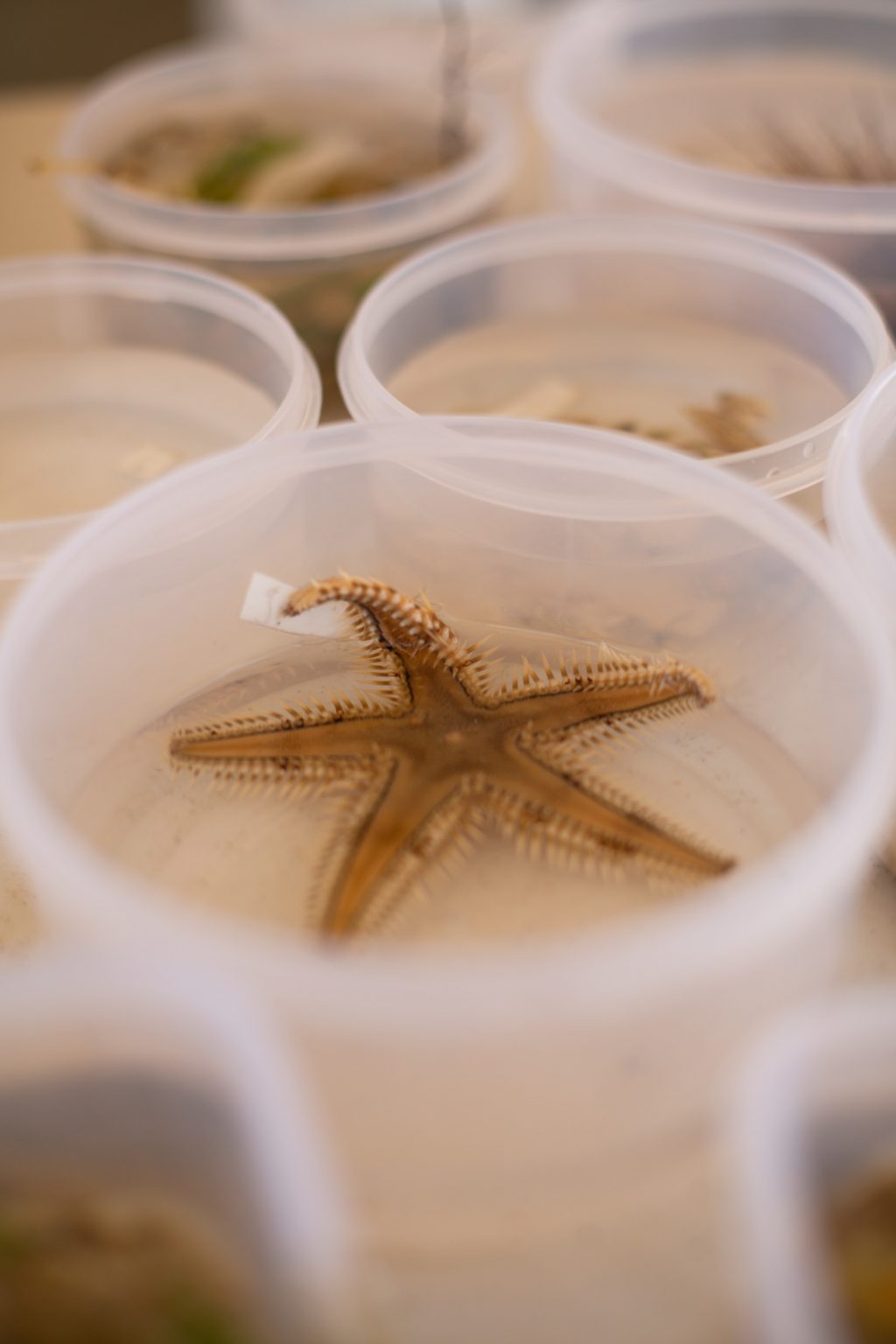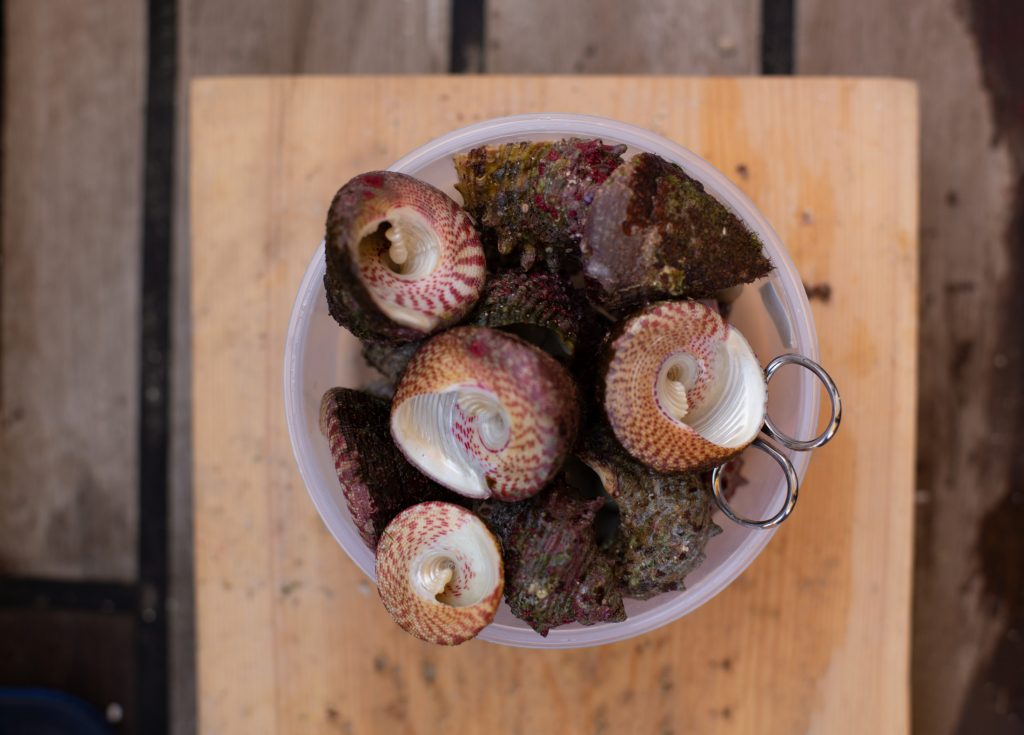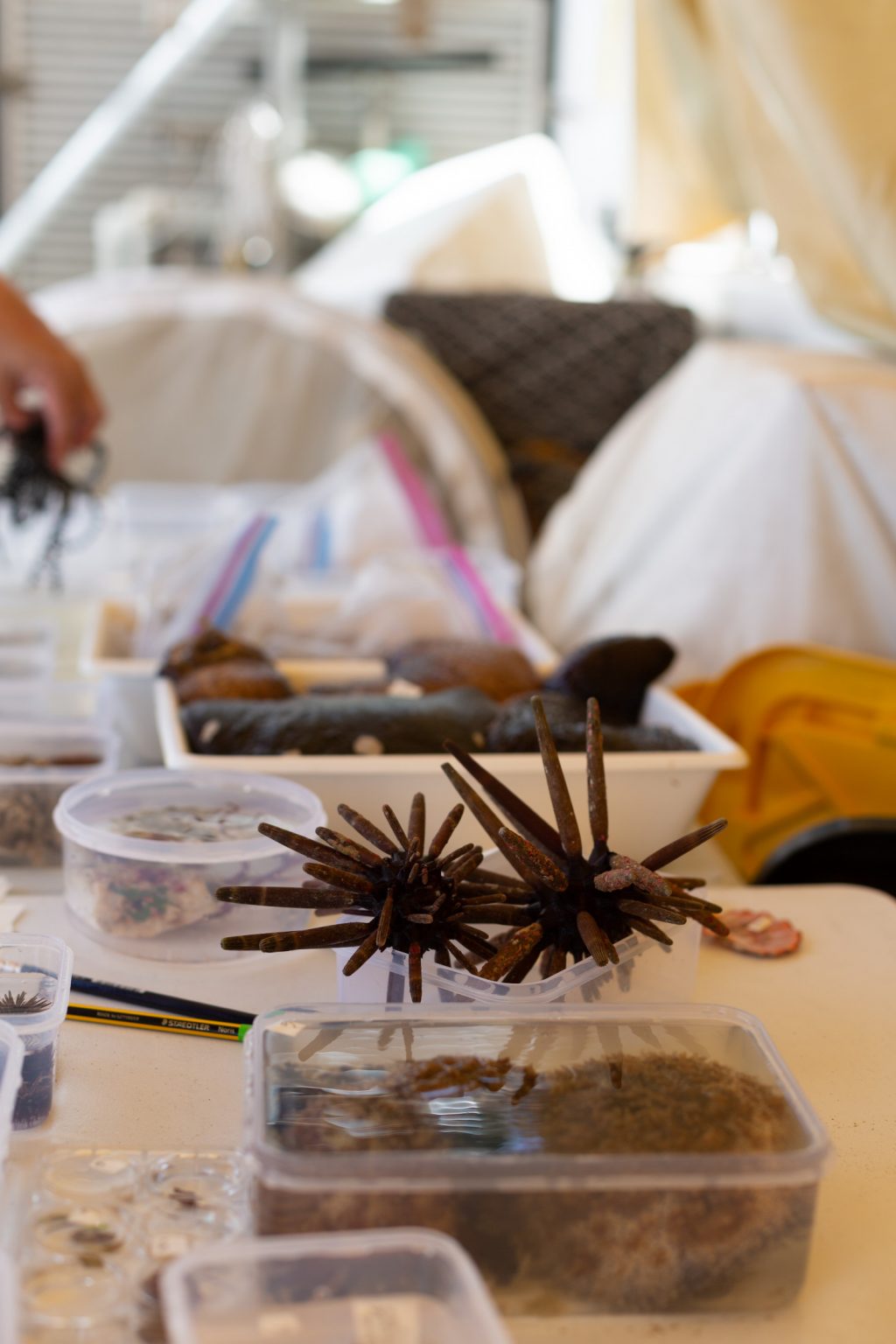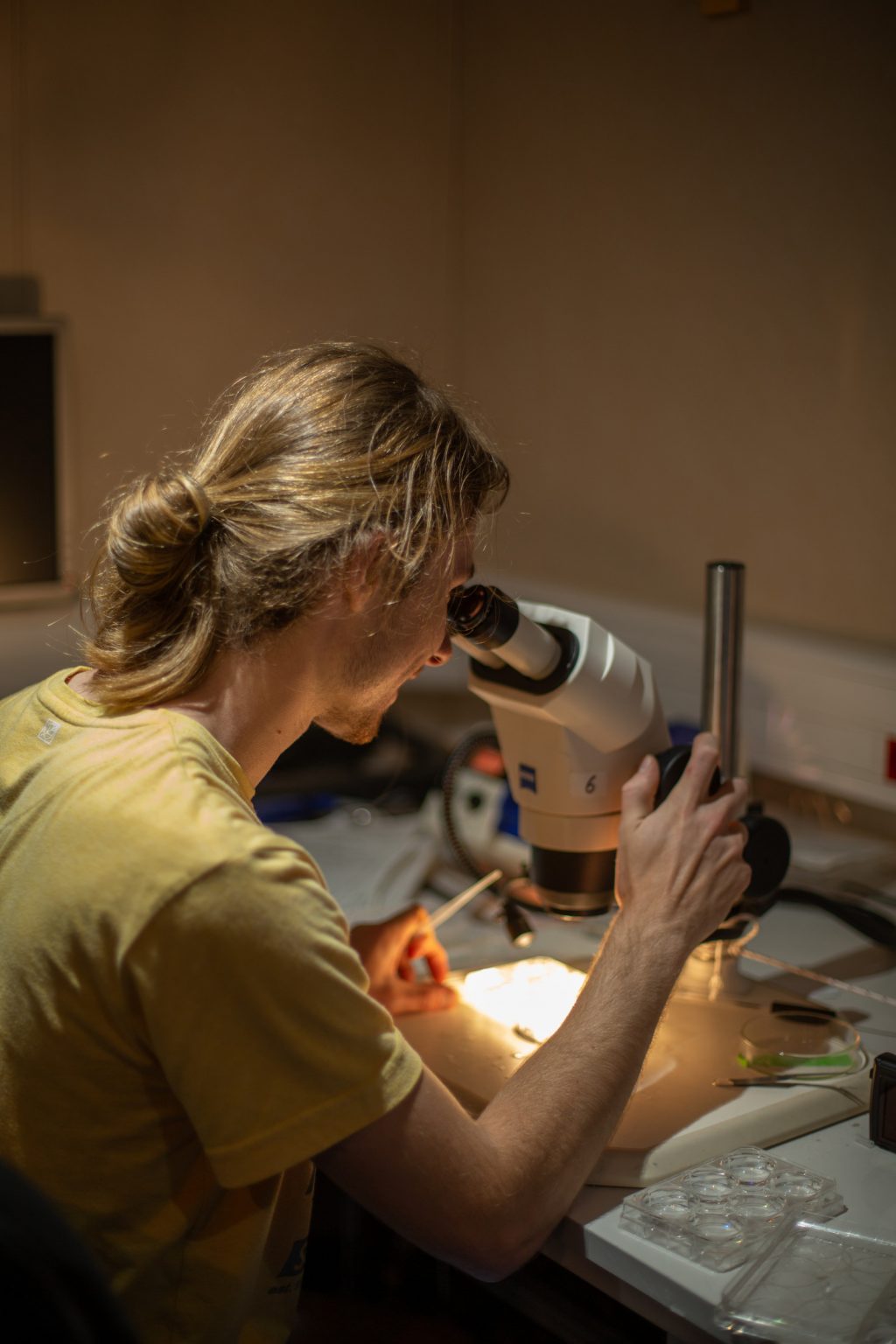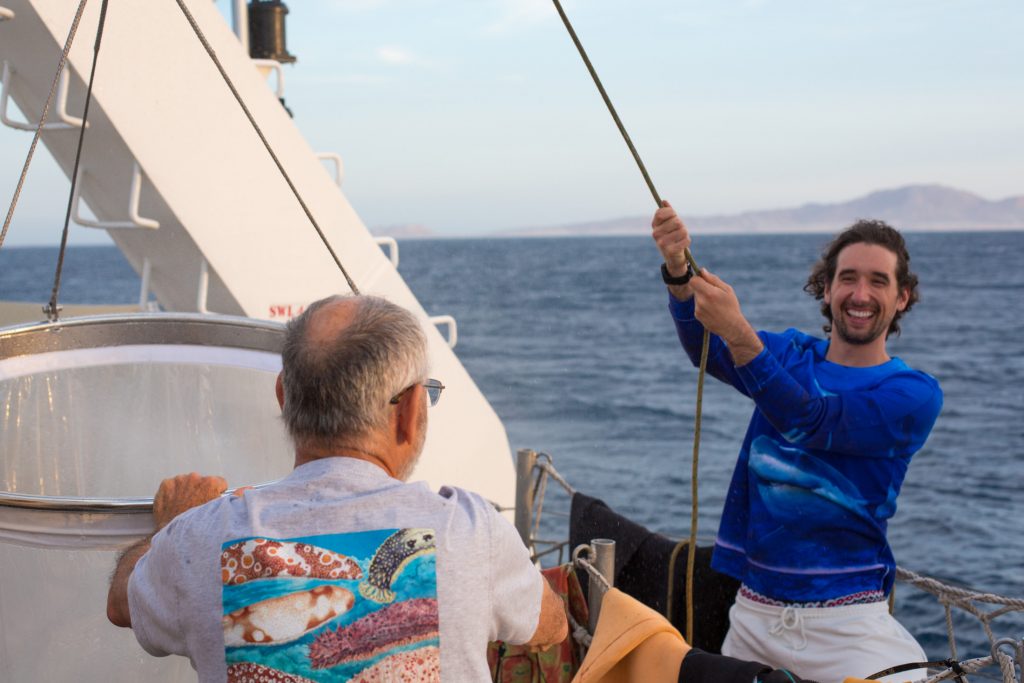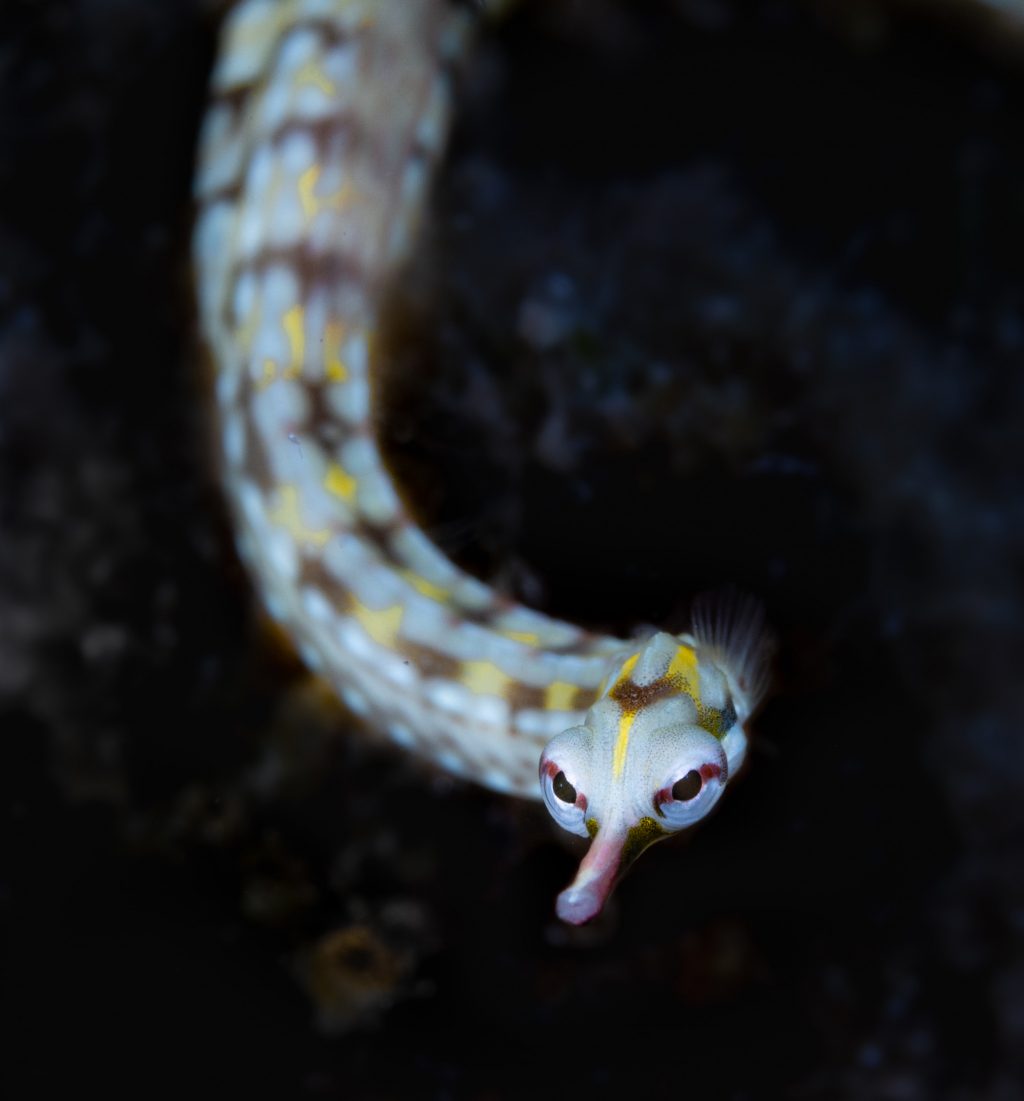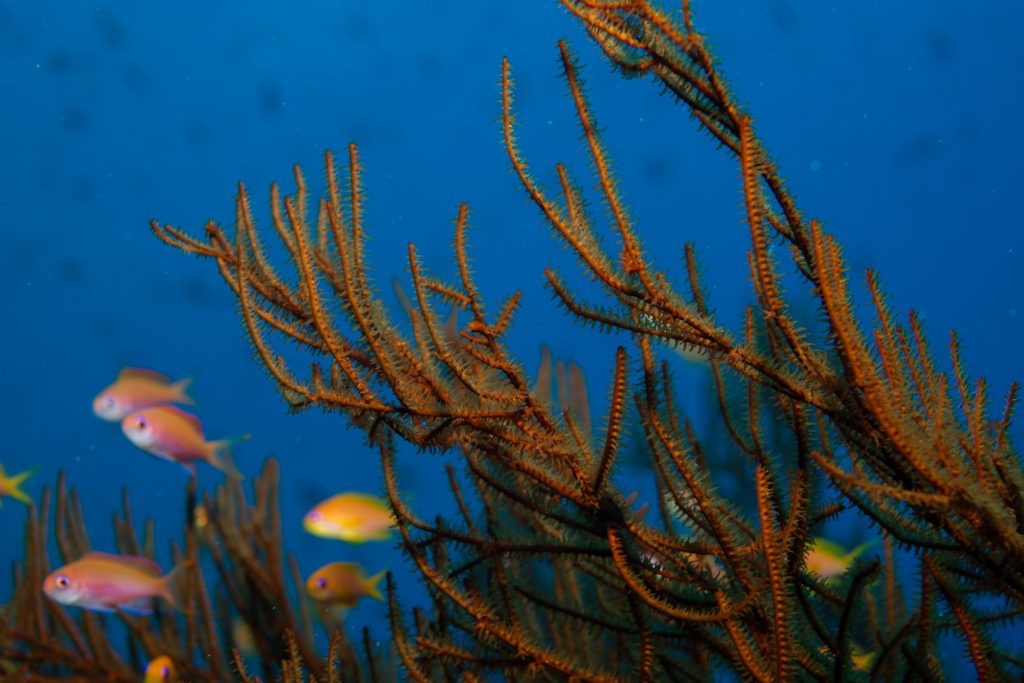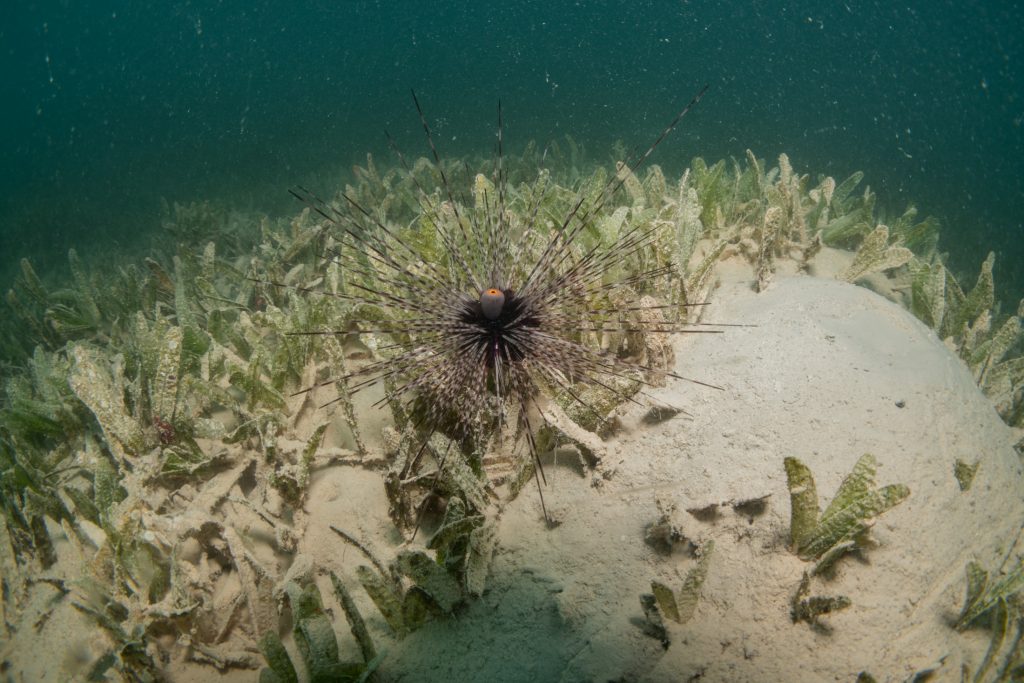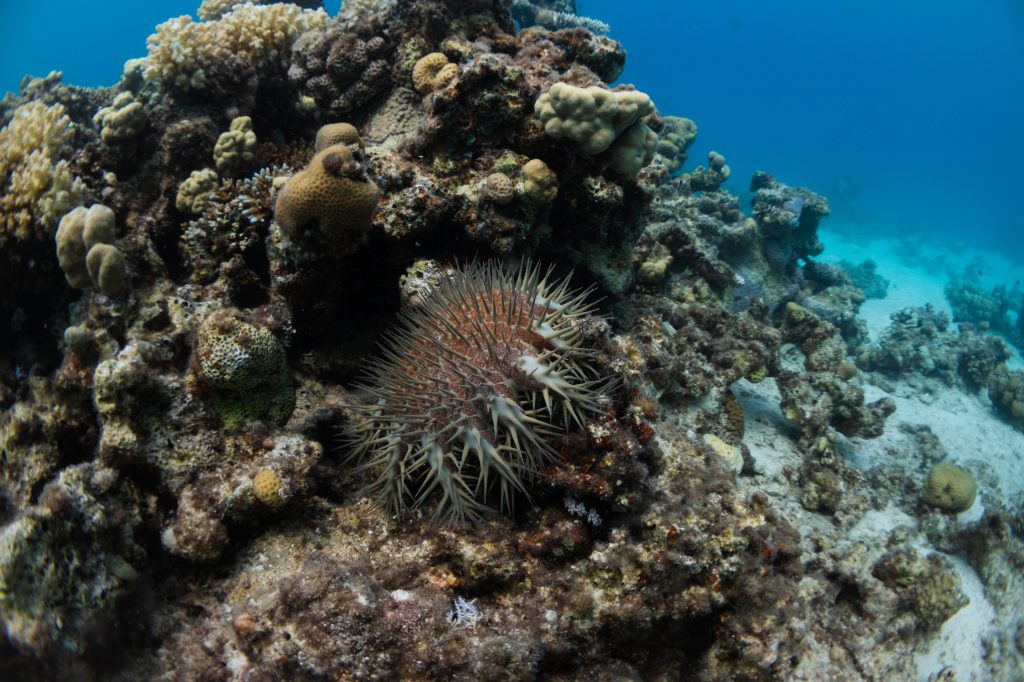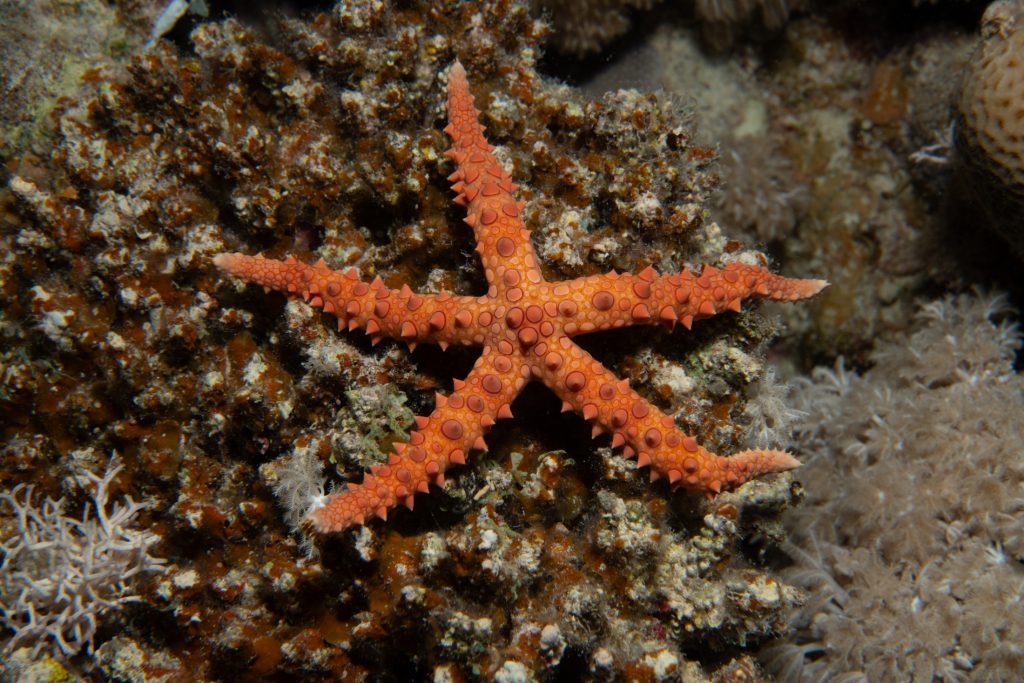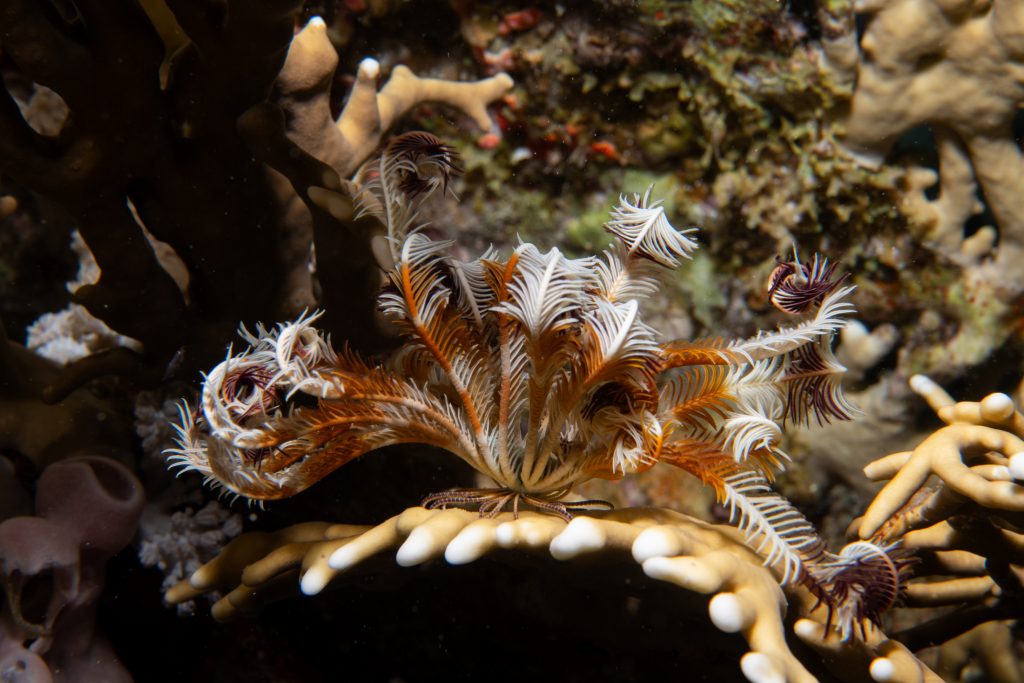Early in May 2023, a small team of marine biologists arrived in the Saudi Arabian city of Jeddah. They’d flown into the local airport from Guam, the United States, Portugal, Spain and Japan, and they’d soon rendezvous with colleagues from the King Abdullah University of Science and Technology (KAUST), a research university built along the banks of the Red Sea.
It was the sea that brought them here. Coral reefs in the narrow ribbon of water between Arabia and Africa are among the world’s most unique. A shallow strait at the mouth of the Red Sea, called the Bab-el-Mandeb — or Gate of Tears — has kept its marine occupants partially isolated for millions of years, leading to high rates of endemism. As much as 14% of the Red Sea’s corals, fishes and mollusks can be found nowhere else.
The Red Sea is also home to some of the world’s most stunning reefs, and scientists have only a vague idea of what lives inside them.
“Almost everything that you see is corals and fish, but that’s just what’s on the surface,” said Gustav Paulay, curator of invertebrate zoology at the Florida Museum of Natural History. “Most of the diversity is within the reef, but it’s difficult to sample.”
Photo by Morgan Bennett-Smith
It’s estimated that nearly three-fourths of all species inhabiting coral reefs worldwide have yet to be discovered, but the ongoing threats of climate change, ocean acidification and human development won’t wait for scientists to catch up. If global temperatures rise 2% above the preindustrial average within the next century, as predicted by most climate models, 99% of coral reefs will likely disappear.
Paulay made the long trip from Florida to Saudi Arabia to work with Susana Carvalho, a professor at KAUST’s Red Sea Research Center, who uses new technology to speed up the process of biodiversity discovery in coral reefs. She takes samples of sediment or water and mixes each, blending together all the itinerant plankton, larvae and suspended tissue particles into a genetic slushy. Special enzymes pick out the DNA strands, which Carvalho and her team then use to create a roster of all the organisms in a given sample. In the Red Sea and most other marine environments, the final tally contains glaring gaps.
“In most cases, we don’t know what species or even what group we’re looking at,” Carvalho said. “That led us to the idea that we needed to bring in taxonomists that could document what we have and help us improve local reference collections, including DNA reference libraries. This is the only way we can take advantage of the full potential of molecular-based biodiversity assessments in the future.”

Paulay had previously worked in the Red Sea and recently concluded extensive reef surveys in the nearby Arabian Sea and Gulf of Oman. Carvalho asked if he’d return for another Red Sea expedition, this one along the northwest corner of Saudi Arabia, where a vast and ambitious development project is currently underway.
So it was that Paulay and his colleagues found themselves packing large duffel bags full of scientific equipment into SUVs at KAUST before setting off on the eight-hour drive up the coast.
The ship they’d chartered to conduct coral reef surveys had two generators, and one of them was broken. Needing both, a third was bolted to the afterdeck, taking up most of the available space where the researchers would soon prepare their specimens. It also added a significant amount of weight to the ship. This shifted its center of gravity, making it top-heavy and more likely to capsize in turbulent weather. But the waves were calm, and the sky was clear, and soon they were sailing north along the coast toward the Gulf of Aqaba.
The great rift
The Red Sea is a world like no other. Beginning roughly 30 million years ago, a chasm opened between Africa and Arabia as their continental plates split apart. Water from the Indian Ocean spilled into the breach, carrying with it a retinue of primordial fish and invertebrates. The widening rift down the Red Sea’s spine forms an abyssal trench nearly 2 miles deep at its lowest point; at the bottom, a thin patina of sediment and organic debris press down on magma tubes that heat the surrounding water to temperatures in excess of 160 degrees Fahrenheit. Even at a distance from these areas of tectonic activity, the water remains a balmy 68 F at the greatest depths.
“Deep seas are cold-water environments,” Paulay said, adding that temperatures hover just above the freezing point of water in most places. “One of the most bizarre aspects of the deep Red Sea is its warmth.”
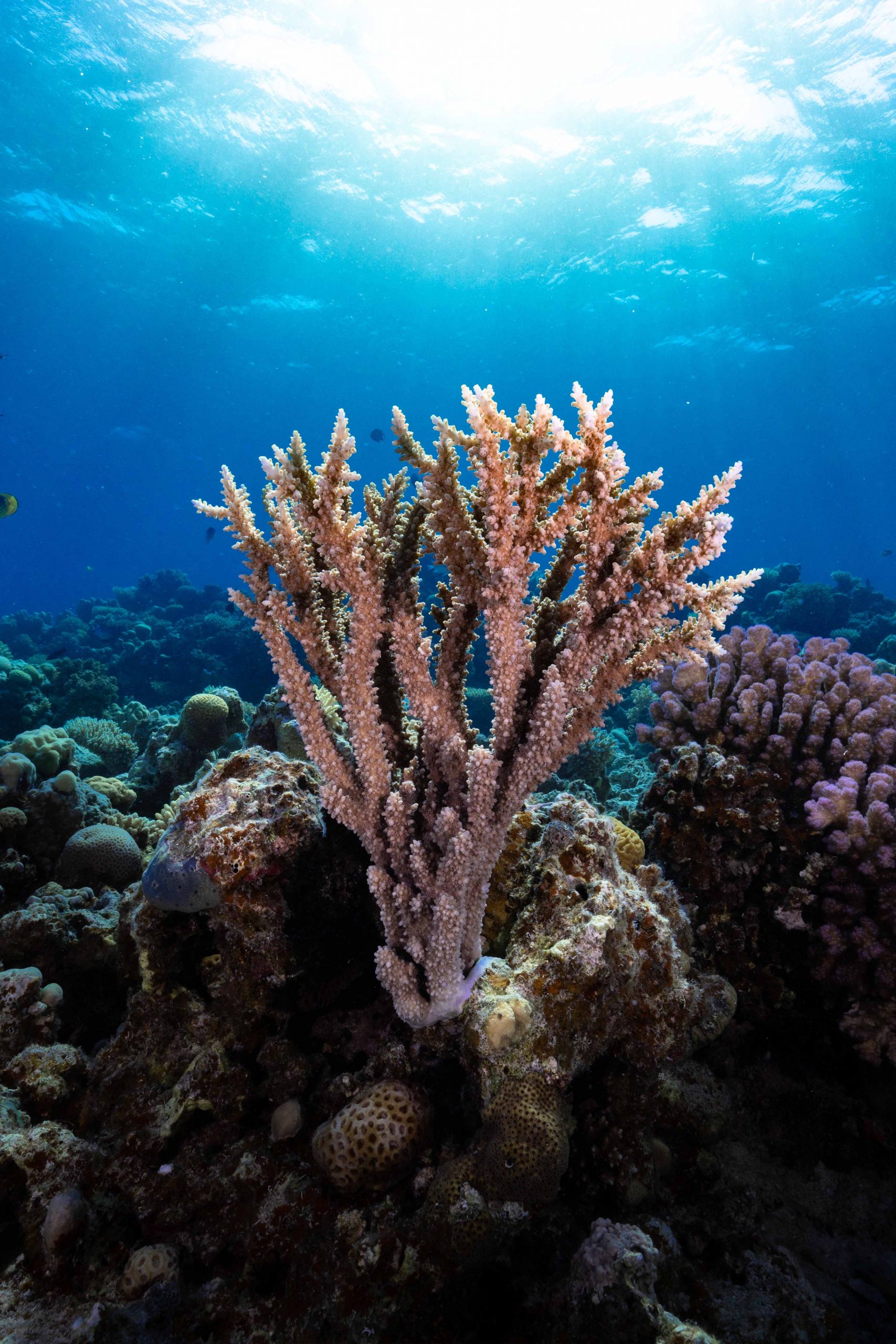
Photo courtesy of Morgan Bennett-Smith
Its shores extend for 1,400 miles, surrounded by deserts on all sides. There are no rivers that flow into the Red Sea, and more than 6 feet of water evaporates from its surface each year. The basin is refilled by the Indian Ocean through the slender Gate of Tears. Its limited connectivity to other bodies of water make the Red Sea a reservoir for salt, which precipitates and sinks to the bottom. The seafloor is dimpled with salt domes miles thick and brine pools that instantly pickle any organism unlucky enough to fall in. Nearby sulfur chimneys belch thick plumes of super-heated sulfide and metal, covering their surroundings with a dragon’s hoard of manganese, gold, silver, zinc and lead worth trillions.
During the Pleistocene epoch, glaciers radiated from the poles and lowered sea level by over 300 feet. The Red Sea repeatedly shrank and was either partially or entirely cut off from the Indian Ocean. This caused a spike in salt concentration that seems to have killed most corals in the northern half of the sea. All but a few of the corals currently inhabiting waters around Saudi Arabia and Egypt are likely recent arrivals, moving in when sea levels rose after the last ice age 10,000 years ago. Corals repeatedly sprung up along the entire length of the sea, colonizing and adding to reef platforms created by their predecessors in eons past.
Today, the sea receives few nutrients from land, except in times of flood, making it the last place you might expect to find thriving reef communities. In normal circumstances, a lack of nutrients inhibits the growth of algae, which in turn limits the size of fish and invertebrate populations. Such environments are marine deserts, and they are especially common in the open ocean.
Photo courtesy of Morgan-Bennett Smith
Closer to shore, where water is shallow and light is abundant, many corals form a symbiotic relationship with algae, in which each produces vital nutrients the other needs to survive. The coral hunts using barbed stinging cells; after they’ve digested their food, the waste is used to fertilize their algal tenants. In return, the algae give their coral host a portion of the sugar produced through photosynthesis.
“Reefs are, in part, a response to low-nutrient conditions,” Paulay said. “The symbiosis between coral and algae allows both to be more resilient to a lack of nutrients than either organism would be on their own. The northern end of the Red Sea is at the extreme end of the nutrient spectrum, which means you get vibrant corals and phenomenal water clarity.”
‘The Line’
The zephyr-blue water periodically burst into a panoply of bright hues as the research vessel glided over shoals and reefs. Oval patch reefs reach up from the ocean floor like pillars. Elsewhere in the vicinity, these living stalagmites are strewn with the wreckage of unwary ships whose hulls they punctured. Avoiding these and other hazards, the research team sampled from 32 locations in an arc more than 60 miles long.
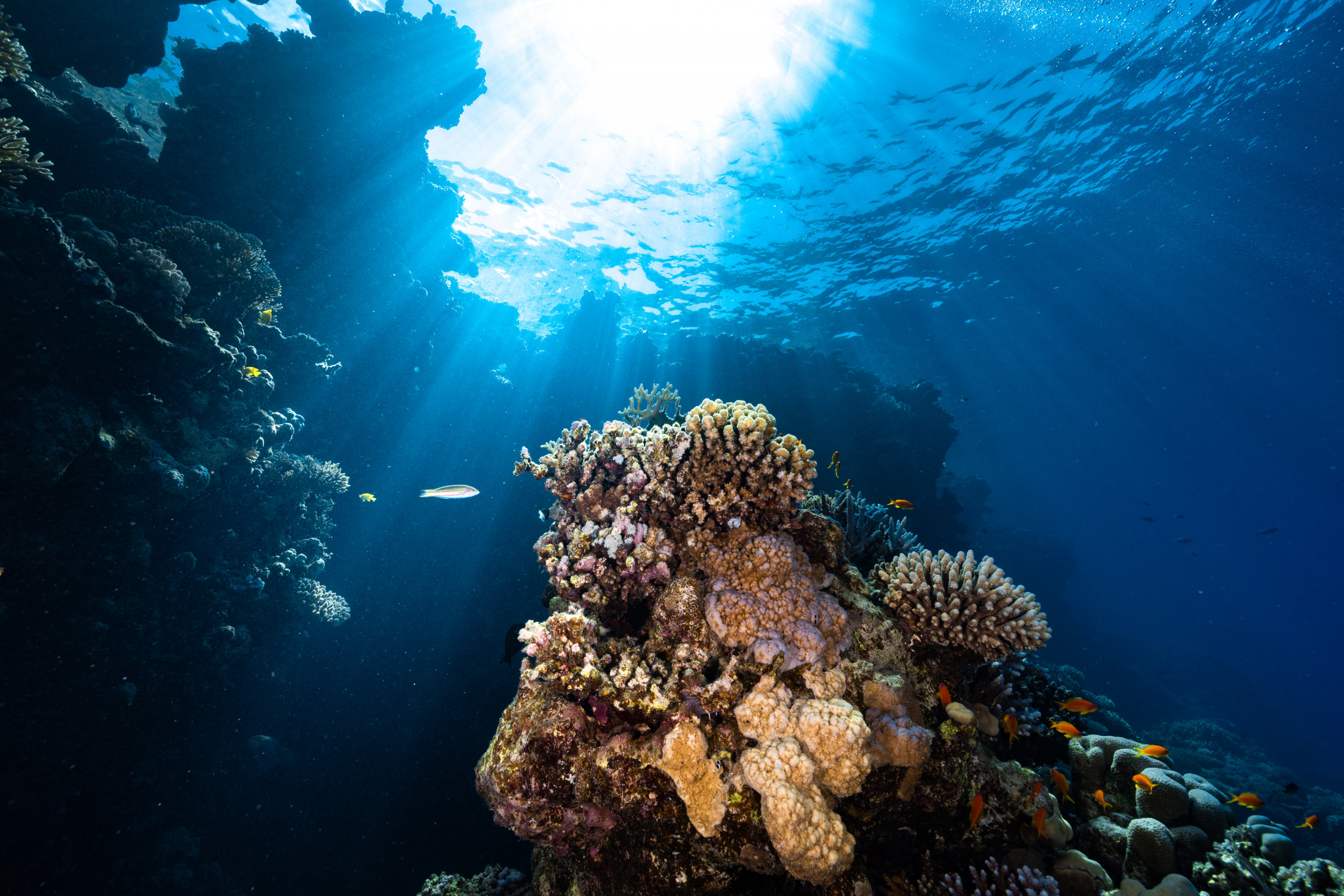
Photo courtesy of Morgan Bennett-Smith
In some ways, Paulay sees himself as an archivist. Species are currently disappearing hundreds to thousands of times faster than the normal background rate of extinction, and with rapid climate change and continued human expansion on the horizon, this trend shows no sign of diminishing. To Paulay, this continued decline of biodiversity is a near inevitability, and he hopes to create a record of as many species as possible before they are lost. With any luck, the tragedy might even be temporary. If the budding science of de-extinction comes to fruition, future scientists may be able to reconstruct extinct organisms using preserved tissue and DNA, bringing them back to life.
In other scientific corners, human records of extinct animals are already among the only available portals to the past. Recently extinct island birds, like the dodo, are a stark example.
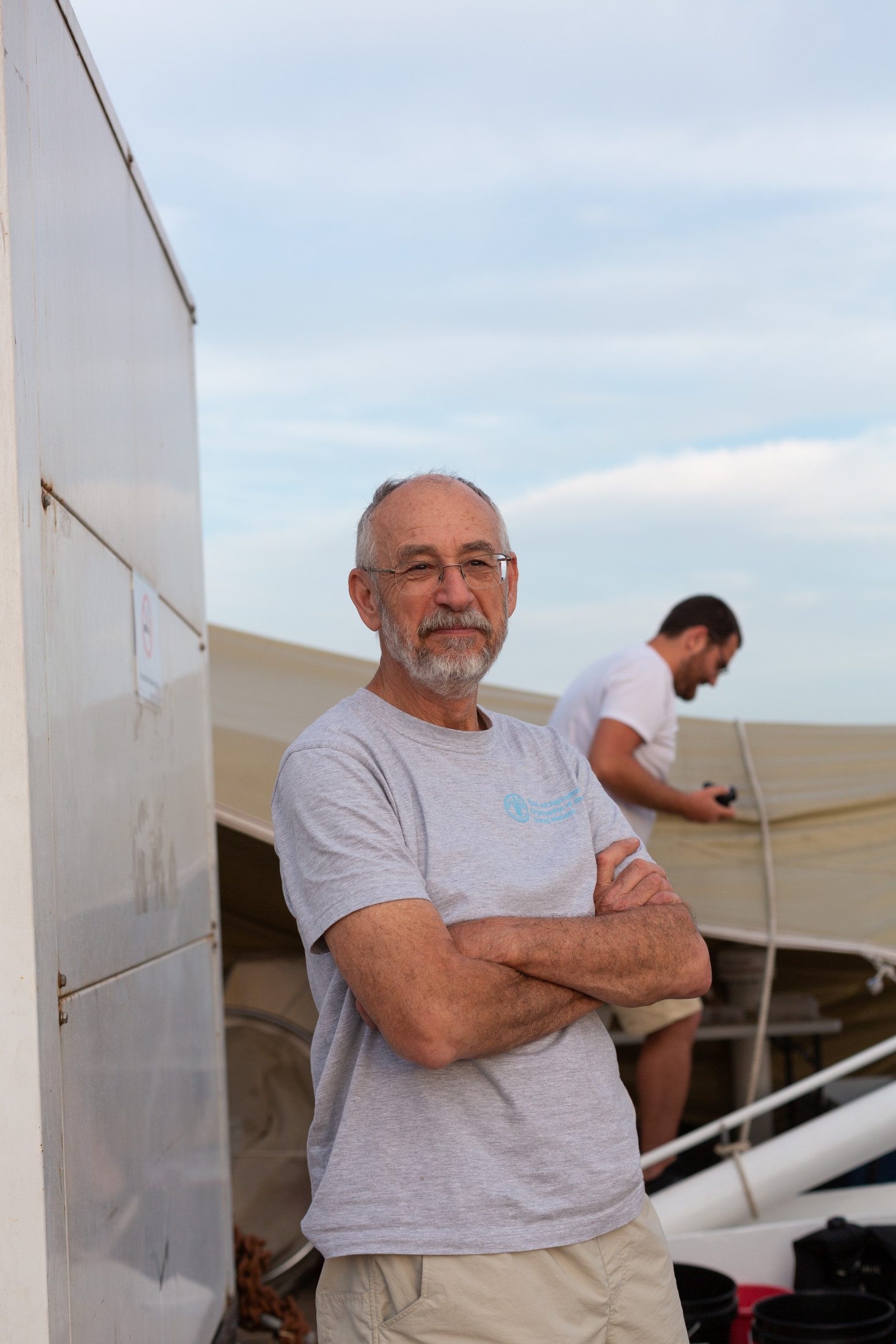
Photo courtesy of Diana Noto
“Everything we know about those birds, other than the skeletons, is dependent on whatever explorers recorded about the animals when they were living,” he said. “That’s what’s happening to so much of the world. Many aspects of life on Earth in the future are going to be known only from notes, imagery, specimens and genetics that are recorded today.”
Paulay has created a streamlined, industrial-scale process in which teams collect whole components of an ecosystem, photograph individual specimens, sequence DNA and store everything — including the organism — for future study. The laborious task of describing new species is left for later; instead, organisms of unknown affinity are more expediently labeled as MOTUs — molecular operational taxonomic units.
Using these methods, Paulay and his colleagues have documented as much as 2% of the known diversity of marine invertebrates during seven surveys conducted over a single year.
These assessments of biodiversity are especially important in areas zoned for nearby development. Just a few miles inland from the expedition’s midpoint, construction crews were busy digging the foundations for a city unlike anything ever attempted by humans. The city’s design consists of two parallel rows of skyscrapers that rise from the banks of the Red Sea and extend at a right angle 150 miles into the desert. In early plans for the city, the towers are each designed to be 1,600 feet tall, with a small gap less than 700 feet wide in between, crisscrossed by arches above and connected by a subterranean railway system below.
The city, simply called ‘The Line,’ is designed to run entirely on renewable energy and will feature short commutes, nature parks and a complete absence of cars.
The monumental project is just one part of a much broader development and stimulus initiative, called Vision 2030, announced by King Salman in 2016. It includes plans for new mountain and island resorts, a floating port city on the Red Sea, revitalization projects in 12 cities across the country, and expansive wind and solar farms to power it all.
Before building in areas near the sea, officials want to have a better idea of what lives inside it. Taking full stock of any reef would be a leviathan task, but it’s especially difficult in the Red Sea. Iconic coral formations like the Great Barrier Reef and the Caribbean’s network of fringe reefs have historically received the lion’s share of scientific attention.
What little is known of the Red Sea’s inhabitants often doesn’t hold up to scrutiny. What is considered to be one species can turn out to be several, a recurring pattern that Carvalho compared to nesting Matryoshka dolls. “You take one and realize there’s another and another,” she said.
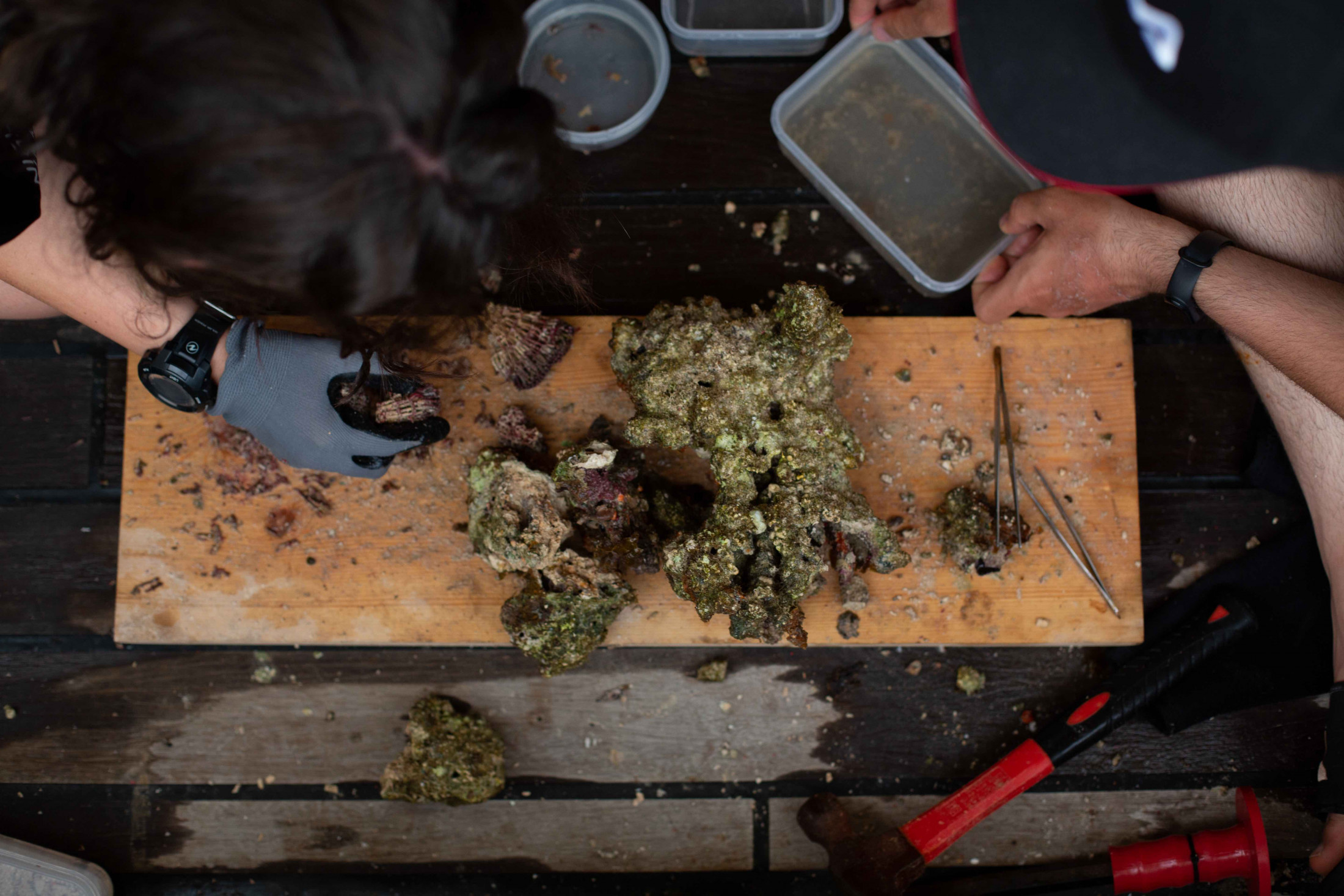
Photo courtesy of Diana Noto
This aura of uncertainty surrounding the Red Sea’s biodiversity has rapidly changed over the last decade.
When KAUST first opened its doors in 2009, it placed a strong emphasis on the assessment of marine biodiversity. The university’s Red Sea Research Center attracts faculty and graduate students from around the world and is entirely dedicated to understanding life in the Red Sea and the forces that influence it. The institute’s current director, Michael Berumen, launched a series of survey expeditions in 2012. Paulay and his colleagues participated in seven of these surveys and returned home laden with specimens that are now curated and studied at the Florida Museum of Natural History.
In 2011, the nearby King Abdulaziz University in the port city of Jeddah launched the Red Sea Biodiversity Project in partnership with the Senckenberg Research Institute of Germany. One of the main goals of this project was to establish a museum collection consisting of organisms from the Red Sea. This led to a flurry of new species discoveries and the influx of more marine specialists to the area. Other institutions and projects have recently followed, including the Reefscape Restoration Initiative launched in 2021, the nascent Global Coral R&D Accelerator Platform Foundation established in 2023, and the forthcoming Marine Life Institute, currently under construction in Triple Bay.
For anyone hoping to unravel the complexity of the Red Sea’s reefs, Saudi Arabia is the place to be.
A rainforest amid deserts
The crew members passed low sand dunes and hills punctuated by the occasional palm tree as they made their way north. Calm, turquoise lagoons gently dip away from the banks to the depth of a few feet before curving back up toward the elevated fringe reefs a few miles out. The lagoons and other portions of the backreef are randomly dotted with knolls of coral and miniature patch reefs, like rubble strewn about the base of a mountain range. Toward the open sea, the reef forms small foothills, with outjutting crags of cauliflower and leaf corals. Small cliffs encrusted with stony coral stop just short of the water’s surface, where they’re bisected at intervals by sand chutes that fan out onto the seafloor in an alluvial amphitheater of bone, shell and sediment.
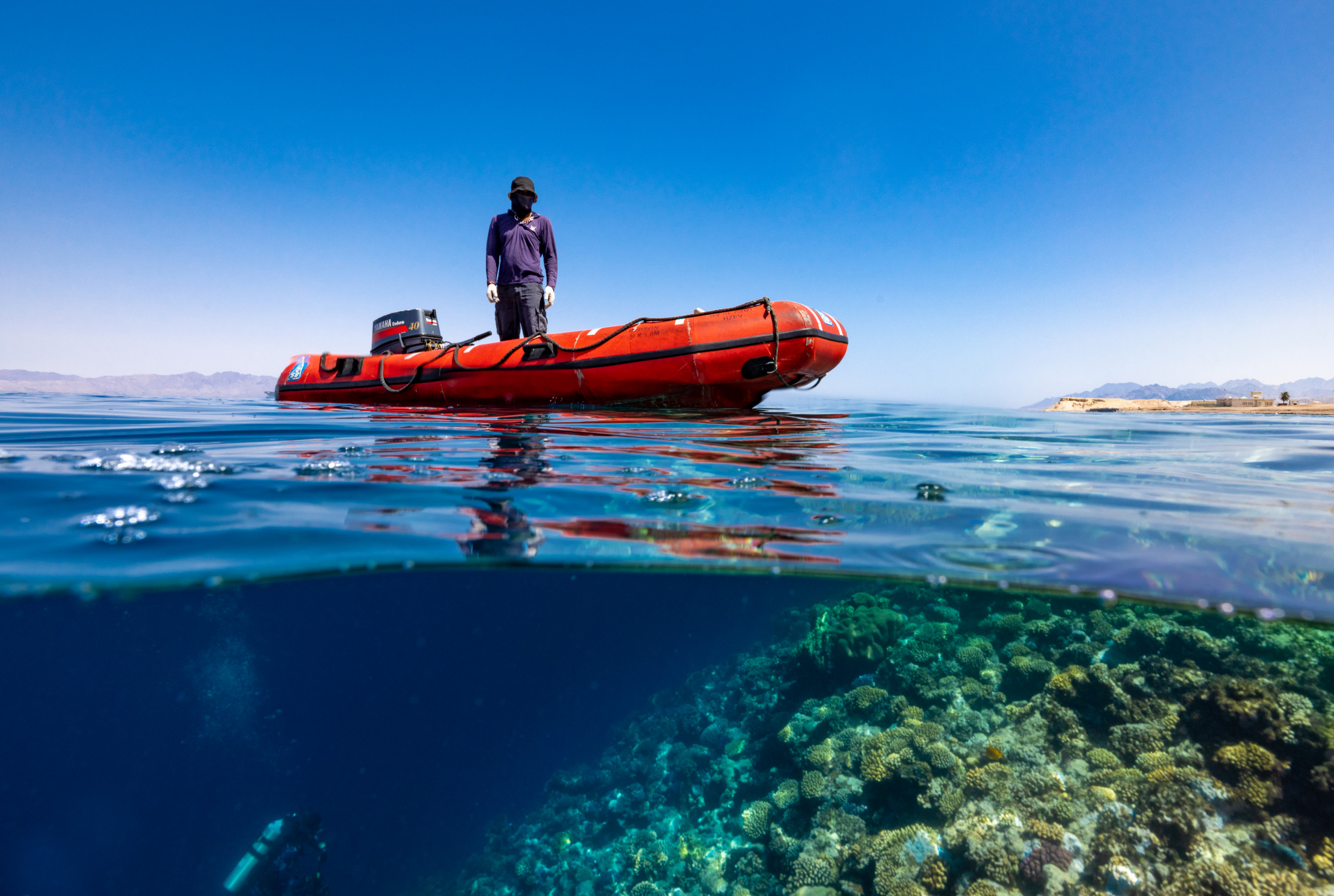
Photo courtesy of Morgan Bennett-Smith
On top, the reef flattens into a broad roof pockmarked by fissures, blow holes and fish-sized tunnels. Unable to cope with dry air, the corals here grow a few inches beneath the low tide line, where the reef explodes in a firework display of color and contour. Organ pipes extend a gaudy bouquet of green polyps above their crimson stems; fire corals weave a latticework of yellow branches sheathed in a fine layer of semi-transparent stinging hairs; and staghorn corals fork into candelabras with white, lance-like tips and stems the color of candlelight. Verdant lawns of algae spread out in all directions, tended by grazing fish and errant sea urchins.
All of this is mere window dressing compared to the inventory of plants and animals that cling to the forereef. The roof terminates in a short slope that juts out into the sea. Past this crest, the reef abruptly plunges dozens of feet into the water, creating a submarine precipice lavishly covered in living coral.
“The reef is a light-driven environment, so everything grows toward the surface. It’s like a forest with a canopy,” Paulay said. “As a consequence of these two factors, the relief is enormous. There are towering walls and channels that just blow me away. It’s a wonderland.”
The crest of the forereef receives the brunt of incoming waves, and corals that grow here often consist of crusts or flattened boulders oriented into the swell, parting the onrush of seawater like a fin. There are corals that resemble gramophones, lichens, inverted umbrellas and bonsai trees. Massive clumps of Platygyra are the size and shape of elephant brains, with neon-colored grooves and ridges, while Dendronephthya overshadow the reefscape like cumulonimbus clouds perpetually frozen in the glow of sunset.
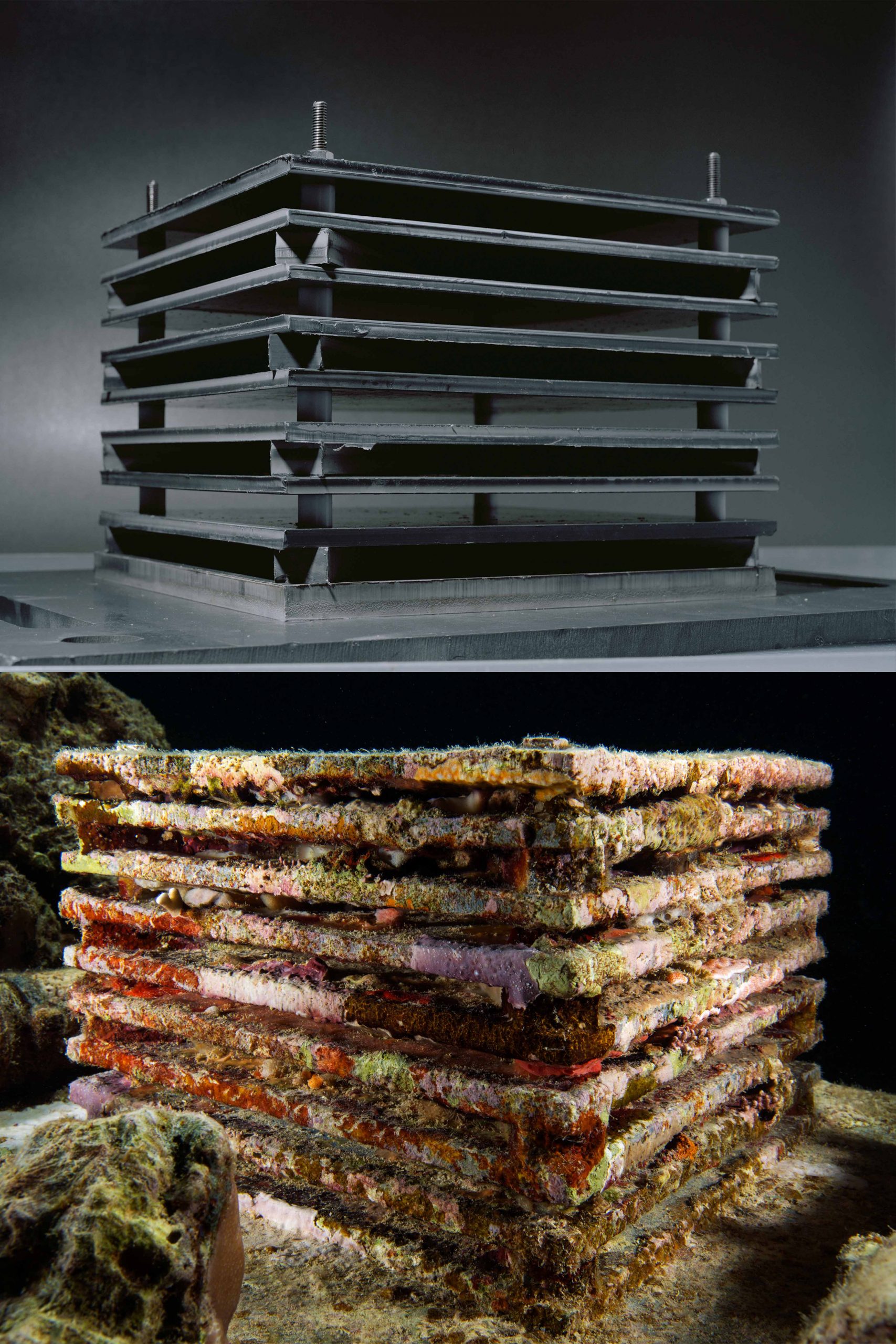
Photo courtesy of Nico Krebs / Taiyo Onorato
Just above this light show, the research crew aboard the vessel split into two teams. The first would place Autonomous Reef Monitoring Systems — called ARMS — at strategic locations along the reefs. Each device consists of PVC plates stacked on top of each other, with a space in between for invertebrates and fish to inhabit. These artificial reefs are later removed after a predetermined amount of time and taken back to the lab, where they can be used to study subtle differences within and between reefs.
The second team collected organisms using bulk sampling techniques as well as methods suited for specific groups of organisms that corresponded with each individual’s area of expertise. Topside, Soma Elefánti, a graduate student from the University of Florida, dragged a long, conical net behind the ship to scoop up drifting plankton. Below, a graduate student from Japan’s University of the Ryukyus peered into the hollow spires of sponges to collect the worms that live inside. And Lasley, an expert on crustaceans, sifted through the rock and rubble in search of diminutive crabs. Reef debris of a certain type is more likely to conceal crabs than others, and Lasley surveyed with a discerning eye while noting differences in crab abundance and diversity compared with other places he’s worked.
“I’ve become a sort of connoisseur of reef rocks,” he said. “I’ve been to places in the coral triangle where you can go out on a semi-degraded reef and find a different species of crab roughly every minute. Here you flip 10 rocks, and you might find one species of crab.”
Paulay, a jack-of-all-trades, collected a bit of everything while keeping an eye peeled for the giant photosynthetic clams he has a particular fascination with. After returning to the ship, everyone discussed the highlights, showing off one eye-opening specimen after another.
“We all learn from each other, and everybody becomes a better taxonomist, a better biodiversity specialist, by doing these trips,” Paulay said in an interview given during the expedition. “I think that’s really important. In this day and age, that kind of talent is diminishing.”
By the end of the expedition, they had collected no fewer than 6,000 specimens. Most of these will be curated at the Florida Museum of Natural History, where researchers will be able to study them and analyze their DNA. Results from this work will add to the list of known organisms in the Red Sea and make it easier for scientists like Carvalho to continue the process of documenting Red Sea biodiversity by conducting additional surveys and deploying reef-monitoring devices. If reefs continue to decline, the data will also be a crucial yardstick for assessing the severity of damage and a model for healthy reefs in future restoration work.
The world’s last reefs
There’s a glimmer of hope for Red Sea reefs. Sea surface temperatures in the tropics have increased by 0.72 degrees Fahrenheit to over 1.8 F over the last several decades. Abnormally warm water is usually a death sentence for corals. In most areas, even a slight increase is enough to push the corals or internal algae beyond their thermal limit, causing the symbiosis to break down. Deprived of their main source of nutrition, the bone-white corals that remain slowly starve to death.
Scientists have observed thousands of such bleaching events since records were first kept in 1963, and the documented rate at which they occur is increasing in lockstep with rising temperatures.
Models predicting the future of coral reefs are grim. According to the Intergovernmental Panel on Climate Change, there may be none left a century from now, with one possible exception. Reefs in the northern Red Sea have been surprisingly resilient to global warming. Whereas most corals cop out at 1.8 F or 3.6 F above average, those in the northern Red Sea can withstand a jump of up to 10.8 F under laboratory settings. As of yet, there’s no consensus on whether corals in the real world will have the same level of tolerance, but it does show they’re capable of adapting.
Image courtesy of Morgan-Bennett Smith
The secret of their peculiar resilience lies in the region’s tumultuous past. When sea levels rose after the last ice age, the Red Sea again regained a full connection to the Indian Ocean, and corals adapted to those warm, tropical waters dispersed through the Gate of Tears and slowly made their way north. In the Gulf of Aqaba, the descendants of these first coral pioneers now live in cooler waters but are still able to survive temperature spikes that, up to this point, have mirrored the conditions of their former habitats further south.
If nothing is done to mitigate the runaway climate change that’s come to define the industrial age, the Red Sea could soon harbor the world’s last coral reefs.
Their health will begin to wane long before then, however. Recent research indicates the growth of coral has begun to slow as the water around them heats up. The carbon dioxide primarily responsible for changes in Earth’s average temperature also isn’t confined to the atmosphere. It percolates into the world’s oceans, where it reacts with water and lowers the pH. This makes it harder for corals — and many other marine invertebrates — to obtain the calcium needed to grow their external skeletons.
Ignoring all other risks that threaten corals worldwide, including oil spills, development and overfishing, reefs may ultimately succumb to the ongoing shift in water temperature and nutrient availability. During the summer, the southern half of the Red Sea churns as nutrient-laden water from the Indian Ocean rises to the surfaces and inundates coastal reefs. This influx of nutrients isn’t enough to damage the reefs by itself, but when combined with temperature extremes, it can be deadly. According to Carvalho, it’s already causing long-term damage in the sea’s southern reefs.
“Some of my students and postdocs just came back from a survey 300 kilometers south of Jeddah, where the reefs were hit by a coral bleaching event in 2015 and 2016. We’re now well into 2023, and the northern reefs have yet to recover.”
Contingency efforts are underway. Researchers have submerged metal platforms in the Red Sea that act as coral nurseries. When a natural reef is damaged or suffers a small bleaching event, corals from these nurseries can be used to fill in the gaps and hasten recovery. Other studies have tested the efficacy of artificial reefs to help bolster the region’s biodiversity. KAUST, meanwhile, launched a high-tech restoration program in 2021, with plans to build the world’s largest coral nursery facility, capable of producing 400,000 corals a year.
Probiotics are another promising remedy for ailing reefs, and one in which the Red Sea figures prominently. Corals in the northern Red Sea may get their resilience to high temperatures from their photosynthetic partners. If that’s the case, it may be possible to impart that same resilience to corals in different areas by administering a probiotic tincture of zooxanthellae sourced from the northern Red Sea. Genetic techniques may additionally be able to boost the thermal tolerance of corals, accomplishing in the span of decades what took millions of years for natural selection to achieve.
But none of these options is guaranteed to work. The best insurance we have for the future, Carvalho said, is protecting what we already have.
“The success associated with restoration efforts is getting better, but it’s still challenging at large spatial scales and expensive,” she said. “We really need to focus on what we can do to protect these ecosystems and prevent them from becoming degraded in the first place. One critical step is to identify local pressures and alleviate them.”
If all else fails, Paulay intends to leave behind a thorough record of what once existed. He and his colleagues have conducted marine survey expeditions in the Middle East, Southeast Asia, Hawaii and coastal Peru, among other places. He already plans to help with future surveys in the Red Sea, where reefs are — for the moment — still thriving.
“We have this window until things deteriorate further to understand,” he said. “These kinds of expeditions are about that.”
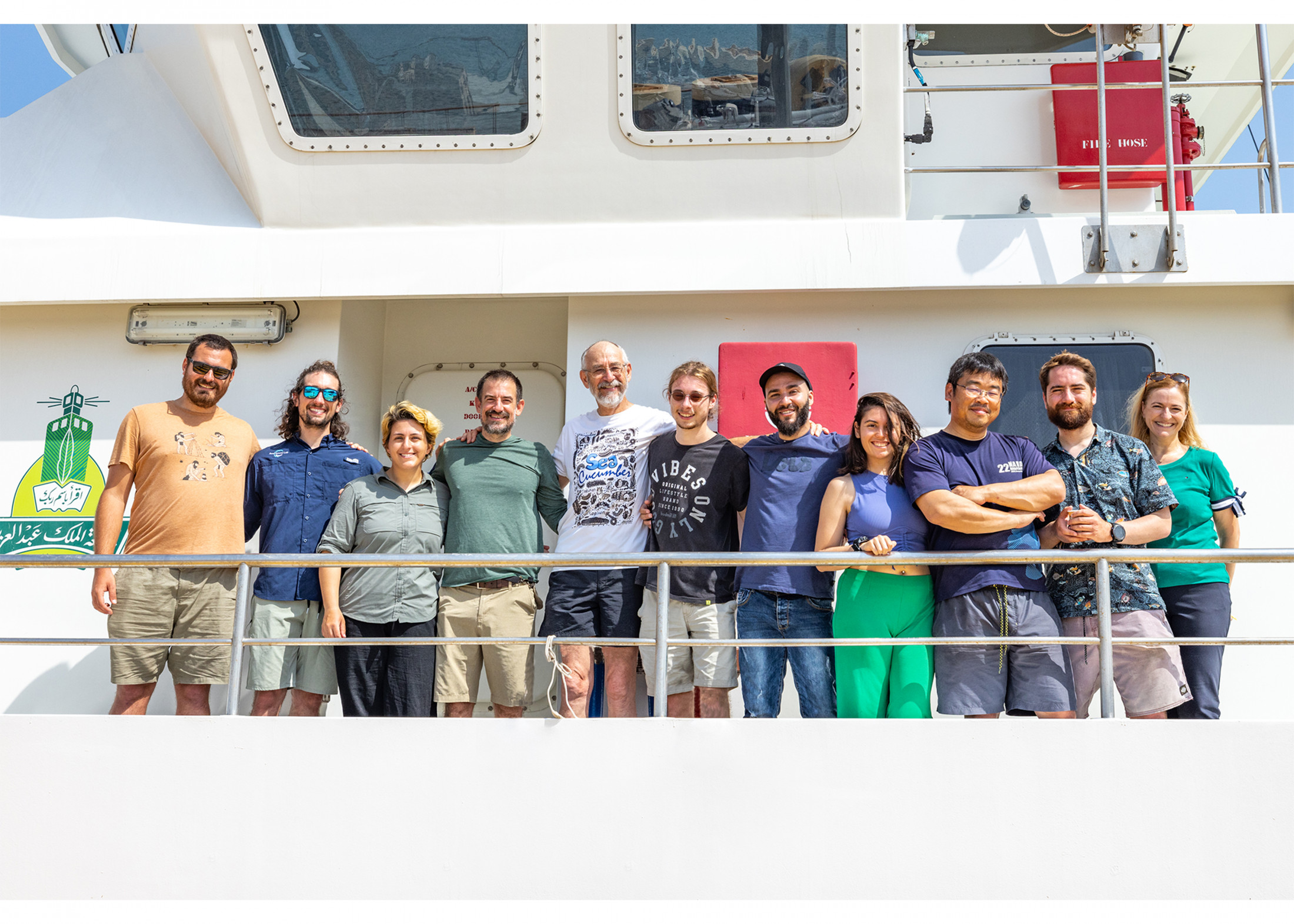
Photo courtesy of Morgan-Bennett Smith
Source: Gustav Paulay, paulay@flmnh.ufl.edu,
Writer: Jerald Pinson, jpinson@flmnh.ufl.edu, 352-294-0452
